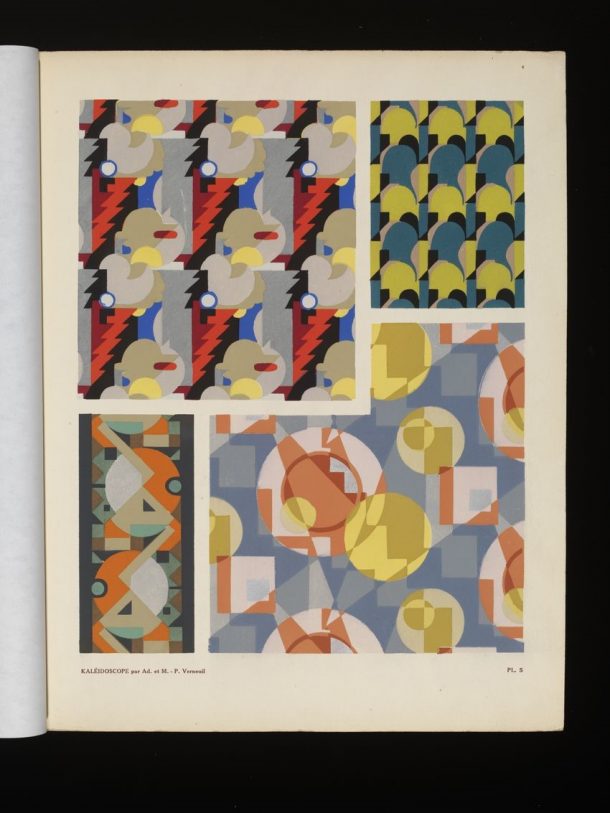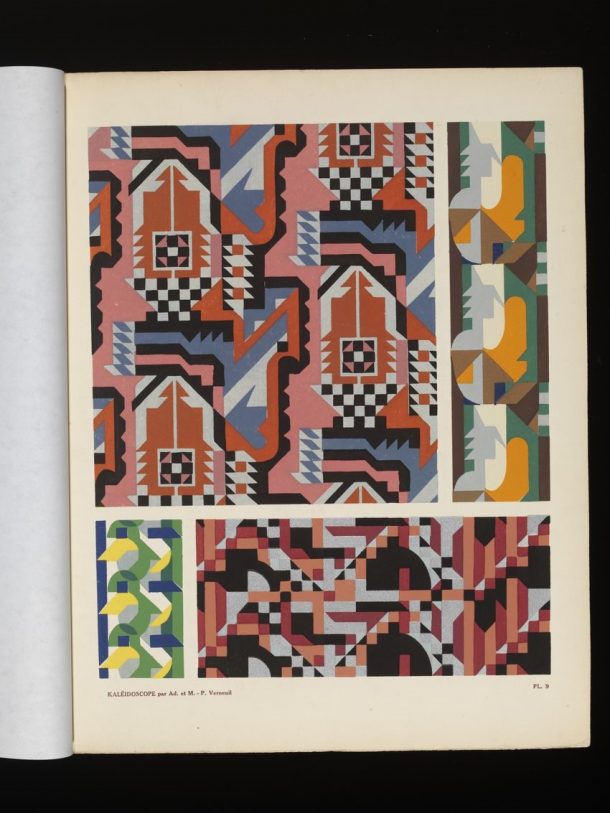Posted on behalf of Fionnuala Deasy, former staff member of the V&A (Trainee Service Assistant in the National Art Library 2017 – 2018).
The reading rooms of the National Art Library may look ornately Victorian, but within the shelves of our collections we have wonderful objects from every artistic time period. One of these fantastic objects is a masterpiece of the Art Deco movement, Kaléidoscope, ornements abstraits; quatre-vingt-sept motifs en vingt planches (1926). This vividly coloured portfolio of prints by French artists Ad. and M. P. Verneuil contains 87 different designs for textiles. Each page offers an exciting explosion of colour, with patterns composed of repeated geometric shapes. The asymmetrical arrangement adds to the brilliance of the variegated designs.
This style is characteristic of Art Deco, a global art movement that took its name from a world’s fair, held in 1925 in Paris, titled Exposition Internationale des arts décoratifs et industriels modernes. This was where the city’s avant-garde could display their new style of work for the first time. The exciting decorative arts shown at this exhibition combined modernist styles with a sense of nostalgia for the glamour of bygone times. One of the first global design movements, Art Deco transformed the design of furniture, ceramics, glassware, fashion, textiles, architecture, prints and ocean liners internationally.

The authors of this portfolio, the Vereneuils, were living in Paris at the time of the exhibition, and patterns they produced encompass the distinctive bright colours and bold geometric shapes of Art Deco that instantly evoke a sense of luxury and glamour. A mystery of the book is who the ‘Ad’ in the title refers to; ‘M.P’ was the French artist Maurice Pillard Verneuil (1869-1942), but where some sources suggest that ‘Ad’ was his brother Adam, others write that the book was coproduced by his wife Adelaide. Either way, the two artists worked together to produce this magnificent pattern book.
Pattern books grew in popularity in the nineteenth century, as the status of design and the applied arts rose. In England, the artist and designer William Morris did much to encourage collaboration among all of the arts. Pattern design, of which Morris was a master, became gradually more respected, both here and in France. In Kaleidoscope, the Verenueils used the form of the nineteenth century pattern book to create templates for textile designers to transfer to fabric.

Verneuil, A., Verneuil, M. P. and Saudé Jean (1926) Kaléidoscope, ornements abstraits: quatre-vingt-sept motifs en vingt planches. Paris: A. Lévy. Available for request at the National Art Library (plate no. 9)
This book continues to inspire designers today, and one of the patterns has been selected by British-based sofa maker Sofa Workshop as part of a collaboration with the V&A to explore the museum’s collections. The original design has been carefully recreated and recoloured, transforming the pattern into a furnishing fabric to cover a range of upholstered furniture suitable for the modern home.



